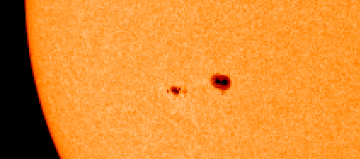 Did you miss the aurora surprise of August 7th? Next time get a wake-up call: Spaceweather PHONE.
Did you miss the aurora surprise of August 7th? Next time get a wake-up call: Spaceweather PHONE.
MARTIAN MISINFORMATION: Contrary to a wide-spread report, Mars will not appear as large as the full Moon this weekend. There is, however, something truly astronomical to draw you outdoors--a morning alignment of Venus and Saturn. Get the full story from Science@NASA. Sky maps: Aug 26, Aug 27.
BACKWARD SUNSPOT: Evidence continues to mount that the next solar cycle (Solar Cycle 24) is beginning. For the second time in a month, a backward sunspot has appeared. The first backward spot, sighted on July 31st, was tiny and fleeting. The latest, however, is big and sturdy, bipolar sunspot 905:

A SOHO magnetogram shows the magnetic poles of sunspot 905.
"Backward" means magnetically backward. Compared to how sunspots have been during the past 11-year solar cycle, the north and south magnetic poles of sunspot 905 are reversed. This is what happens when one solar cycle gives way to another--sunspots reverse polarity.
The onset of Solar Cycle 24 is big news, because the cycle is expected to be intense, but don't expect any big storms right away. Solar cycles take years to ramp up to full power. The next Solar Max is expected in 2010.
PLUTO DECLARED A DWARF PLANET: Yesterday at the International Astronomical Union (IAU) General Assembly in Prague, astronomers decided that the Solar System has eight planets, and Pluto is not one of them. Instead, Pluto is a "dwarf planet."
To be a planet, the assembly ruled, a world must meet three criteria:
 (1) It must have enough mass and gravity to gather itself into a ball.
(1) It must have enough mass and gravity to gather itself into a ball.
(2) It must orbit the sun.
(3) It must reign supreme in its own orbit, having "cleared the neighborhood" of other competing bodies.
So, e.g., mighty Jupiter, which circles the sun supreme in its own orbit, is a planet--no adjective required. Pluto, on the other hand, shares the outer solar system with thousands of Pluto-like objects. Because it has not "cleared its own neighborhood," it is a dwarf planet.
This decision clarifies the vocabulary of planetary astronomy while simultaneously upturning 76 years of "Pluto is a planet" pop-culture. Will non-specialists heed Pluto's demotion? That remains to be seen. Meanwhile, according to the IAU, the Solar System has eight planets: Mercury, Venus, Earth, Mars, Jupiter, Saturn, Uranus and Neptune; and three dwarf planets: Ceres, Pluto and 2003 UB313.
IAU Press Release

